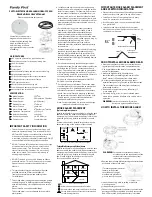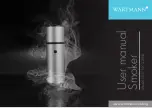
3
automatic calibration, it pays to calibrate as frequently as possible, and certainly, no less than
monthly.
Accuracy.
A properly operating and calibrated detector will respond with the specified
accuracy. If combustible gases other than the gas used for calibration are likely or suspected, the
instrument
cannot
be relied upon to give a proper indication of their concentration and hence of
how close to their combustible limits they may be. For example, the detector responds quite
differently to gasoline, to methane, and to propane. Accordingly, readings of % LEL (or its
equivalent in percent gas) refer only to the calibration gas and can be relied upon only in this
respect in assessing an atmosphere sampled by the detector. Furthermore, concentrations
displayed by the detector refer to a local sample at the tip of the instrument probe. Low gas
concentrations at one spot do not necessarily mean that the gas concentration is low throughout a
wider area.
Note:
All gases detected by a particular instrument are monitored continuously
while using any choice of display.
WARNING:
Each detector responds to the gases for which it was designed. Other
toxic or dangerous gases may not be detected.
B. Operational Description
To conserve the batteries, the selector switch should be in the "OFF" position when the
instrument is not in use.
To Use the % GAS Display.
Connect an appropriate probe to the water-block filter
attached to the hose and turn selector switch to position marked "% GAS". The display shows
"GAS"
for about 15 seconds.
•
After warm-up, the display shows the concentration of natural gas in air in percent by
volume (% GAS). If the air is clean (contains no gas), the display should read zero.
If it does not, switch to position marked "AUTO ZERO". After automatic adjustment
of zero is complete (display shows
"End"
), return the switch to the "% GAS" position.
The % GAS scale spans the whole range of gas in steps of 0.05% from zero to 4.0%
and in steps of 1% from 4 to 100%.
Bar Holing.
The detectors may be used to measure gas levels in sampling holes used for
locating underground natural gas resulting from seepage or leaks in a conduit. Gas
concentrations in a bar hole near a significant leak will exceed several percent. Therefore an
alarm for gas is likely, but it has no relevance to the ambient atmosphere above ground. During
bar-holing, the alarm for the % GAS scale is automatically turned OFF.
To bar hole, select an appropriate probe (see Section 7), set the front panel switch to %
GAS and, after a number appears on the display (typically zero), press the RESET switch on the
front panel. The pump is turned off, the display shows
"go"
and the instrument beeps - it is ready
for bar holing. After inserting the probe into the bar hole, press the RESET switch again. The
pump is turned on and the instrument samples gas for a fixed time
(factory set time is 15
seconds)
. Readings during sampling are shown on the display. At the end of the fixed time for
sampling, the instrument beeps, turns off the pump, and displays the peak (left side of display)
and the sustained (right side of the display) readings. Both values are in % GAS. The instrument
can be returned to the standard display by pressing the RESET switch again.












































